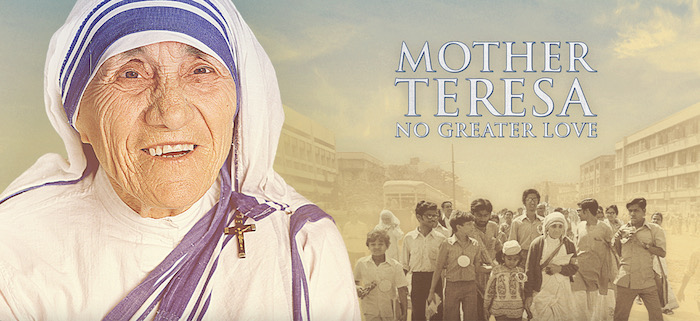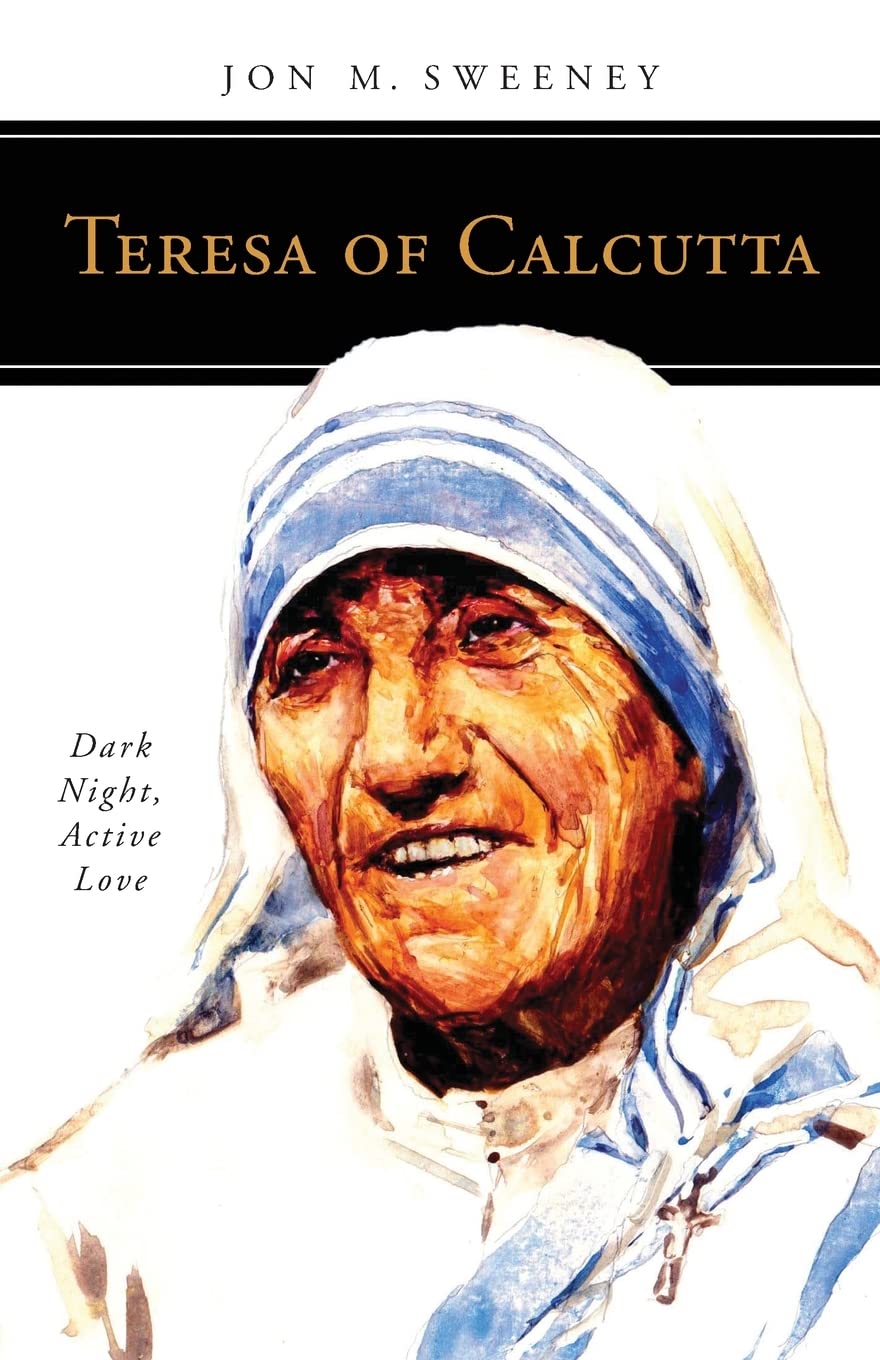
This illustration is from the new documentary, Mother Teresa: No Greater Love. If you click on this image, you will visit the movie’s home page, where you can find out about tickets in your area.
.
Planning to see the movie Oct 3 or 4?
Our tip is: Don’t miss the new book about Teresa.
.
By DAVID CRUMM
Editor of Read The Spirit magazine
As biographer Jon M. Sweeney puts it: Mother Teresa is the world’s first televised saint. That’s an important spiritual truth. We feel we know her because we’ve seen her in action—many, many times over the decades.
So, it is fitting that the 25th anniversary of her death—a date that also is her annual global “feast” on the Catholic calendar—is linked to the debut of a major new movie about her life and two new biographies of the saint. Because of the worldwide scope of the faithful who look to her for inspiration, Teresa was canonized (officially recognized as a saint) by Pope Francis on September 4, 2016.
In his new biography, Teresa of Calcutta: Dark Night, Active Love, Sweeney writes:
Mother Teresa was a woman with a quiet presence but not a quiet personality, and this unnerved some people. It also led directly to her fame and influence. She intuitively knew how to make the most of that fame to support the causes of her charism.
Who Is Mother Teresa?
Born in Albania in 1910, Teresa is best known for her work in India, where she established the Missionaries of Charity, a religious order of women based originally in Calcutta. The Vatican custom of honoring its officially recognized saints includes declaring a global “feast day” for celebration and remembrance, which was set for Teresa as September 5, the day she died in 1997 at age 87.
While originally made famous as “Mother Teresa of Calcutta,” her order of nuns continues to spread around the world and now is active in 133 countries. Her sisters manage homes for people dying of HIV/AIDS, leprosy and tuberculosis. They also run soup kitchens, dispensaries, mobile clinics as well as orphanages and schools.
In the 1960s, Teresa “debuted” in homes across the UK in a special made-for-the-BBC documentary film produced by the famous journalist Malcolm Muggeridge. After that prime-time splash, Teresa never left the global media spotlight.
In the two decades before her death, Teresa was always near the top in the Gallup Poll of most admired people in the world. And, two years after her death, she topped the Gallup List of Most Widely Admired People of the 20th Century, out-polling everyone else by a wide margin. Today, men, women and children around the world continue to be inspired by her life, which is what rapidly pushed the case for her canonization.
This week, with a major new movie and new books debuting, even the secular world is seeing her continuing legacy.
“Over the past week or so, I’ve been seeing all these pieces about Mother Teresa coming my way through social media,” said the Chicago-based Catholic author Chris Stepien (who is online a lot right now because his own best-selling book about Jesus’s youth, Three Days, is debuting in Audible audio this month).
Stepien said, “Most of what I’m seeing come across social media is pointing to the new movie, but of course I’m also interested in the new books.” During a Zoom interview this week, Stepien stood up at this point and walked over to his desk. “I want to show you something. Just look at this: Look at this shelf.” He pointed to a small number of books he likes to keep handy for inspirational reading. Then, he lifted down two of those books: Both about Mother Teresa.
Next up, Stepien plans to read Sweeney’s new biography, which just arrived on his doorstep this weekend.
I asked Stepien, “Why does this woman who lived most of her life halfway around the world mean so much to you today in your life in Chicago? Describe for our readers the intensity of the inspiration you clearly are drawing from her life and example.”
Chris paused a moment before he answered and the first thing he said was, “She had this darkness of the soul and yet she persevered.”
“OK, so Jon Sweeney’s book is perfect for you,” I said. “That’s a central theme in his book.”
Chris went on: “And, when she spoke, she spoke—well, she spoke peace. She spoke mercy.”
“And the intensity of the inspiration that you feel? Put that into words,” I asked.
“OK, remember that these are just my own words,” Chris said. “As a Catholic, the Vatican probably wouldn’t want me to put it quite this way. But I see her as almost a reincarnation of Jesus in our world today. Reincarnation isn’t a good Catholic word, but it describes how much I see Jesus in her. Mother Teresa encourages us to be merciful, to be understanding of others, to meet people where they are. That’s what Jesus did. That’s how Jesus lived his life. That’s how strongly I feel about how she embodied his example for all of us.”
‘A Pivotal Moment in Making Her Case’
In that off-the-cuff description of the inspiration he draws from Teresa, Chris Stepien perfectly describes central themes in Jon Sweeney’s new biography. In Sweeney’s book, Teresa shines brightly despite having experienced decades of a deep spiritual darkness in her own prayer life—and despite the flak she took from outspoken critics who chided her over the years. That’s why Sweeney’s subtitle is Dark Night, Active Love.
“She experienced this darkness—this ‘dark night’ experience in prayer—for so many years and yet she was a person who had an impact that far outreached any of her contemporaries,” Sweeney said. Living a life of faith, despite those years of doubts and spiritual struggles, became a central argument in the case presented to Vatican officials for Teresa’s official recognition as a saint.
“The world knows her dark night story because it was made public by Brian Kolodiejchuk, the postulator of her cause,” a Canadian priest who became the main promoter of her case for canonization upon her death in 1997, Sweeney said. “And I do recommend that people who want to know even more about Teresa get his book, Come Be My Light, where he publicly shares this part of her life.” That 2009 book’s subtitle is, The Private Writings of the Saint of Calcutta.
“In that book, he did a beautiful, sensitive job of presenting the dark night experience, knowing that this revelation would shock the world,” Sweeney said. “And that was a pivotal moment in the making of her case. I’ve never met Kolodiejchuk but I’m a fan of his work. Of course, there were some others who knew about this dark-night experience before his 2009 book came out. So, why wasn’t this made more public before his book? Because I think that it really took the authority of the official champion of her cause to share this with readers around the world—to explain it in a way that they would take seriously. And now it has become an important part of her legacy.”
I said to Sweeney: “And what’s so powerful about that for ordinary folks is that no matter how isolated and alone we feel in our lives, we can look to Teresa and see how she carried on despite those doubts, right?”
“Yes,” he said, “We realize that she accomplished so much in her life, even though she was experiencing this darkness. It adds to her story for so many people.”
A Skeptical Journalist Promotes Her Story
In the middle of Sweeney’s book, he describes Teresa’s dramatic debut in global media in the 1960s, which began with a visit from one of Britain’s best-known skeptical journalists Malcom Muggeridge. He was curious about this woman’s work in Calcutta and arranged to spend five days filming in India with a BBC crew.
Then, some incidents during the production—including the way the black and white images of her were captured on film—convinced Muggeridge that there was something miraculous about Teresa and her work. His enthusiasm made the BBC’s 50-minute Something Beautiful for God a sensation, followed by a book Muggeridge published about her. At the time, he was a Protestant and eventually he converted to Catholicism.
Sweeney compares this story of sudden stardom to what happened to the Trappist monk Thomas Merton after he published his 1948 best-seller The Seven Storey Mountain. Almost over night, Merton inspired a wave of young men to declare their desire to become monks just like him. And, for her part, Teresa’s order of women boomed as a result of the media coverage.
In Teresa’s case, wave after wave of media continued to celebrate her life. This year, at least two new biographies are debuting. In addition to Sweeney’s book, the other frequently mentioned new book is To Love and Be Loved by Jim Towey for Simon & Schuster.
Who doesn’t enjoy a true hero’s story?
As a long-time journalist, author and editor, Sweeney is gracious about recommending many other books about Teresa, especially Kathryn Spink’s 2011 book, Mother Teresa.
“I’m happy to recommend other books about here. There’s always room for more books about Teresa,” Sweeney said in our interview.
Stepien demonstrated that dramatically in his home office in Chicago where he has two within easy reach—and soon will have a third on his shelf: Sweeney’s book.
Here at ReadTheSpirit magazine, we chose to highlight Sweeney’s book over Towey’s new book for one simple reason: Sweeney’s book is an accurate, balanced story of her life that’s perfect for general readers to finish in one or two evenings, depending on how fast they read. For example, Spinks’ book is 368 pages; Sweeney’s is 184 pages—exactly half the length of Spinks’ work.
The concise style and the fresh journalistic perspective in Sweeney’s book also means that it’s a perfect cross-over book for non-Catholics who want to quickly learn more about this spiritual hero. And if you’re wondering about that phrase “spiritual hero”? Well, that phrase is appropriate because “heroic virtue” is one of the traditional standards in the canonization process.
Whatever your faith: Who doesn’t enjoy a true hero’s story?
Overall, then, we’re saying: Sweeney’s book is a perfect choice for Catholics and non-Catholics who want to spark a discussion with friends in their congregations. The book is easy to read, explains the heights and depths of Teresa’s journey, and will prompt a lot of conversation.
As we closed our interview, I asked Sweeney what he hopes readers will take away from his book.
“I hope that readers remember not just this extraordinary person and a few things she did,” Sweeney said. “I hope readers will appreciate and remember what an impact her life and her legacy has on our global culture, writ large. I hope readers will think about how and why she had this enormous impact and learn from her example.”


Just saw “No Greater Love” the Mother Teresa documentary. Powerful! Brought me to tears.